A long time ago I decided to start building a laser cutter. The main argument? To be able to cut the pieces for a new printer. (obviously).
A lot of time passed and I managed to move 2 times in between. Also I got a new job. All good reasons to do a lot of other stuff than writing blogs. Although this site should be documenting my work so it makes sense to have at least a little activity here.
Now – about the 3D printer. I intended to title the post ‘ building a 3d printer in 3 easy steps’, but then again. it’s not easy to build a 3d printer. however, it has become a lot easier than before when ready-made kits where not around on every streetcorner.
This is my old printer – A Sells Mendel. It might not be pretty. But is has been working hard for the last years.
I finished the printer in April 2011 and it has been with me over the course of my master thesis where it was used to make a functional prototype. Furthermore it has been used to print the parts for my new printer.
Now, Time for the new stuff!
The frame
One of the main reasons to get a new frame was the gain of improved stability that a new fram would provide. I really liked the P3 Steel which is an i3 derivative made entirely from 3mm steel plates. heavy – sturdy.
I ordered mine from Orballo printing, a company in Italy. They ship worldwide and after some initial stock issues I got my frame.
About the same size as a arge pizzabox the fram arrived in bubblewrap. I was on the cheap side and chose not to get the anodized version. Don’t be like me. GET THE ANODIZED VERSION!
I had the (at that time great) idea that I wanted a green printer. Now I don’t know why that was such an interresting idea. I got some UV reactive paint (Montana spray paint – crazy stuff) and got to work:
first we prime. metal primer – oh yeah. remember – if you do this sort of stuff alwaysd to get extra paint. and for gods sake. let it dry properly. thin layers will get you far.
bla bla insert some wize word about paint (I don’t know them!) and assemble the frame.
the reason why I would recommend the anodized fram is that the added thickness of the pain actually makes the asembly impossible without the paint chipping off and showing the raw steel again. not cool.
Anyway, It’s pretty easy to assemble the frame. Just be sure that the screws are the right length. It took about 15 minutes to get to the stage above.
Some of the nuts should be flat, but that can easily be solved using a file and some time.
Make one of the sides flat as the picture above and youre good. it should leave room enough so the motors can be mounted flush to the frame.
Leadscrews
I chose to upgrade from the threaded rods I was used to. The thing with threaded rods is that they are intended for strutural use and for tensional forces. they’re not intended for the repetitional moving use that the 3d printers are excerting to them. Instead one should get real leadscrews which are made for motion both ways and has no slack! this will greatly reduce the wobble and layer thickness differences.
Just look at that beauty! The plastic part is made on my old printer and it just glides soooo smoothly on the linear bearings.
Do the same thing for the other side of the printer and you’ll end up with something that looks like this
Okay I took the liberty to mount the X-axis as well. and an extruder. and the Y-axis with bed mount. But you get the idea. The P3 steel is pretty easy to assemble.
The extruder
So the printer sat in a corner for quite some time while I was pondering what extruder to fit. I have tried a direct drive extruder but I never really came to terms with it. In the end I chose to buy a BQ Heatcore for the Hephestos and Witbox printers. It was a bit expensive but then again – It has been proven to work quite good. I’ve only head good about the extruder and I thought it might be a good time to change to 1.75mm filament anyway.
Electronics
I bought a Smoothieboard for the lasercutter but decided to abandon it due to lack of support. What the smoothieboard lacks on the laser cutter side it definetely has on the 3d printer side. I was up and running fairly quickly and hey! I now have a new 3d printer! yay me!
I know that I have left out an awful lot of details.. What should I have written more about?


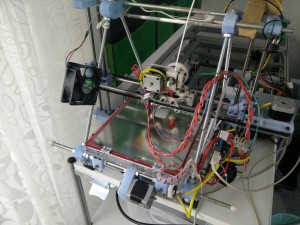

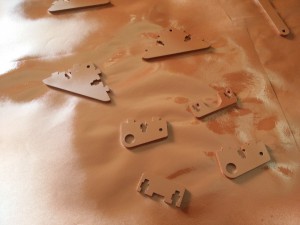
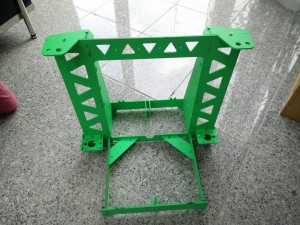
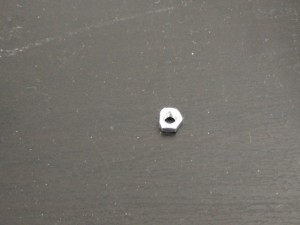
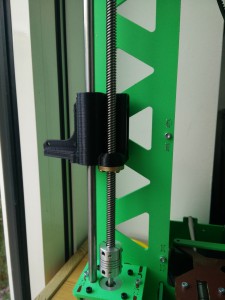
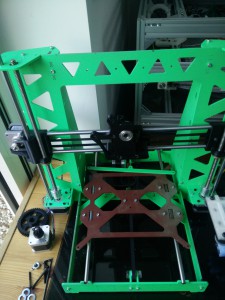
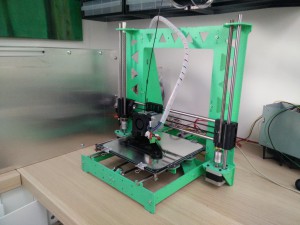
yeah you could write a lot more, especially about what DIDN’T go smoothly!
But that’s great already.
Apparently nothing new since you were using this on the old Mendel, but I’m curious about the mirror you use on the heating board. I’ve used that heat resistant tape, can’t remember the name, which I have to replace regularly.
Does it conduct heat well?
Does the melted plastic stick well to it? How about removing completed parts?
What about the external fan to cool down narrow and high parts ? You have it on the Mendel, did you install one on the new printer as well?
Yeah I know – The problem is that the process took about 4 months with a lot of other work in between. Remembering where I got stock was really hard. I think it was mostly because I needed parts.
What you use is called Kapton tape. A lot of people use that. It works but leaves the bottom layer with the marks of the tape, so if it got ridges when you apply it those ridges will be carried on. The mirror’s got a greater thermal mass so when the build plate is heated it will stay heated for some time. What you probably can’t see is that the mirror is coated with hairspray. This mix will make PLA stick VERY well provided that the distance from bed to extruder is right.
The really nice thing about this setup is that when the bed cools off the object is easy to get free. so basically – heat=stick and cold=non-stick
about the fan(s) the Heatcore has bot a fan for the extruder and a fan for the nozzle built-in. It greatly increases the print quality, although the nozzle fan is amazingly powerful. So powerful that is has overcom the adhesion effect of the bed which is not cool..